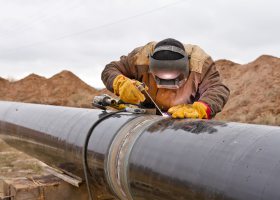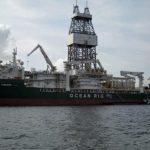18 Stages Of East African Crude Oil Pipeline (EACOP) Construction

Pipeline construction involves multiple steps. Understand the stages help to identify the roles your business can play in the proposed 3.5 billion dollar Uganda-Tanzania pipeline.
Here are the 18 phases of the construction of the East African Crude oil pipeline
1.Construction survey
The first step in the construction of the EACOP project is a civil survey. The survey team will locate facilities such as utility lines, the rights of ways, working spaces and sensitive resources to allow construction activities. Also, survey team might mark the areas for digging trench. This help construction crews to minimize the impact on the surrounding areas as they have a clear picture of the construction activities.
2.Clearing
This phase involves removing all obstacles that can hinder construction process along the pipeline route. It consists cuttings, burning or removal of trees crops vegetations along the construction corridor. Once the area is well cleared, it easy to get construction equipment to the site.Heavy machines such as bulldozers can be used during this activity.
Read.: 7 Opportunities in the Uganda-Tanzania Pipeline Project and How to Participate
3.Grading
The next activity in this construction of EACOP project is grading. This is the leveling of the ground so as to keep safe work and level surface operation for the pipeline construction crew and help heavy machine and huge construction equipment to smoothly operate along the pipeline route. Also since the EACOP passes via various topographies, leveling minimizes excessive pipes bending for example in the areas of steep slopes
4.Top Soil stripping
This activity will include removal of the topsoil from the construction corridor. And this will be done to preserve the original topsoil to its natural state. The topsoil will be protected and replaced once construction is completed.
5.Trenching
The next stage of the EACOP construction process is digging the trench. The top of EACOP to be buried to a minimum of 1.2 meters below the ground surface. During this trenching operation, the crews will use excavators to remove material from the trench
6.Stringing
Once trench operation is finished, the pipe segment will be placed in the dug trench. Trailers can be used to moves pipes from the storage yard to the trench or construction corridor
7.Bending
The EACOP will not go flat land along the route. To fit with topography changes along the pipeline route pipe needs to bend using specialized bent machines so as to fit with land topography
8.Line Up
In this stages of EACOP construction procedures, pipes will be line up one another in the construction corridor
9.Welding
The different sections of the steel pipes will be joined up to form a continuous length. Each joint will be expertly welded to prevent leakage. The proposed EACOP will undergo root bead welding and fill and cap welding
10. X-ray and welded Repair
Once the segment of the pipe is welded the welds will be checked to the x-rays and ultrasonic equipment. This is done to increase the integrity of the pipes. So it ensures welds are safe, secured and would not break. Qualified welders take x-rays of the pipe welds and once they identify any flaws the weld is repaired is cut out and they will make new welds
11.Weld coating
Once the welding is completed and tested, the next step is coating
In this stage, the surface of pipes will be coated so as t minimize and control corrosion risk of the pipes. Welds will be coated prior to being placed to the right of way where all construction activities occur. Before coating crew will make sure the pipes are clean by removing debris and all kinds of dirt that might interact with coatings
12.Coating Inspection
To ensure the surface of pipes are free from defects such as scratches, workers will use high voltage tools specialized equipment to detect any defect before the pipeline is get into the ground
14.Lowering-in
Is the process of getting pipe into the ground.
In this step, the welded pipe will be placed down in the trench. The specialized tracked construction equipment will lift the pipe and lower into the trench. During this phase, precaution is taken to ensure they no damage occurs to coating when they lower pipeline into the trench.
15.As-Built survey.
This survey performed over the course of the pipeline construction to record all changes happen as pipeline construction is in progress. This provides important information to know the level of completion the project reached. This helps to make any changes to ensure they meet construction schedule.
16.Pad and backfill
This activity will involve place back the excavated subsoil into the trench. You fill back the material back into the trench or hole you previously dug.This involves refilling the trench to cover pipeline with both top and subsoil. Topsoil removed during topsoil stripping phase and subsoil removed during trench digging will be placed back to cover the pipeline
17.As built survey
Again, survey team carried out the as-built survey is carried out after completion of the pipeline construction to identify whether the job is done well. Survey team record information what was actually constructed.
18. Clean up and remediation
The final stage of EACOP construction is clean up and remediation. This activity is done to turn the construction site as close to its original pre construction condition. Example of activity taking place at this stage is the removal of construction materials, remove from large rocks, perform final grading etc
+255655376543/+255678183677
Hussein.Boffu@tanzaniapetroleum.com



